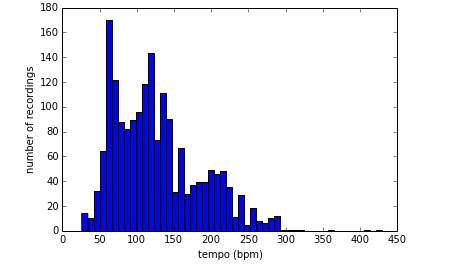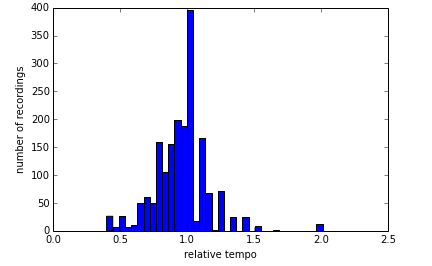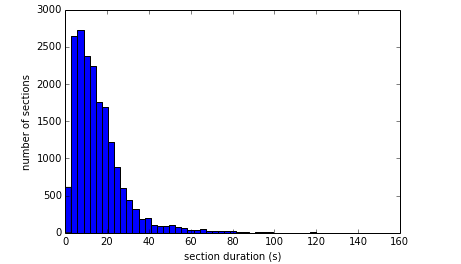Results of score informed audio analysis
In Dunya Makam, we have mostly focused on score informed analysis and description of audio recordings. In the first step, we apply partial audio score alignment to identify the tonic frequency [1] and estimate the tempo [2]. From the tonic frequency, we also obtain the ahenk (transposition) of the performance. We link the sections in the score to the corresponding time-intervals in the audio recording [3] and then obtain a note-level alignment by applying a more precise alignment intra-section [4]. Afterwards, we correct the octave errors in the predominant melody by referring to the symbolic pitch heights of the aligned notes. From the corrected predominant melody, we compute the audio seyir model proposed in [5]. Finally, we aggregate the pitch trajectories for each note symbol from the note-level alignments and compute a pitch distribution based model for each note symbol in the performance.
So far, we have aligned 1767 audio-score pairs. From the alignment we have extracted around 18.770 sections and 745.739 notes. Below, we refer to the statistics for some of the results obtained from the whole audio-score collection using the methodology above.
Score informed tonic identification
Distribution of tonic frequencies |
Distribution of Ahenks |

|

|
Score informed tempo estimation
Distribution of tempo
|
Distribution of tempo relative to the nominal tempo in score
|
Audio-score alignment
Distribution of number of notes
|
Distribution of number of sections
|
Distribution of number of sections duration
|
References
- Şentürk, S., Gulati, S., and Serra, X. (2013). Score informed tonic identification for makam music of Turkey. In Proceedings of 14th International Society for Music Information Retrieval Conference, pages 175–180, Curitiba, Brazil.
- Holzapfel, A., Şimşekli U., Şentürk S., and Cemgil A. T. (2015). Section-level Modeling of Musical Audio for Linking Performances to Scores in Turkish Makam Music. In Proceedings of IEEE International Conference on Acoustics, Speech and Signal Processing (ICASSP), pages 141–145, Brisbane, Australia.
- Şentürk, S., Holzapfel, A., and Serra, X. (2014). Linking scores and audio recordings in makam music of Turkey. Journal of New Music Research, 43:34–52.
- Şentürk, S., Gulati, S., and Serra, X. (2014). Towards alignment of score and audio recordings of Ottoman-Turkish makam music. In Proceedings of 4th International Workshop on Folk Music Analysis, pages 57–60, Istanbul, Turkey.
- B. Bozkurt (2015). Computational analysis of overall melodic progression for Turkish Makam Music. In Penser l’improvisation, pages 289–298, Delatour France, Sampzon.

